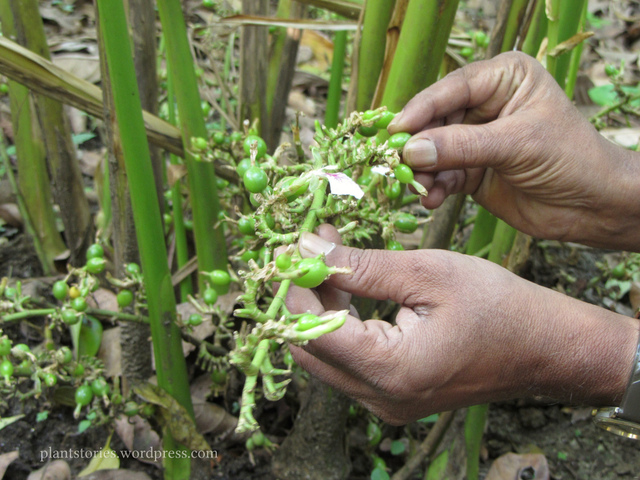Cardamom
Elettaria cardamomum (L.) Maton
Zingiberaceae
Cardamom grows naturally on the coast of Malabar in southwestern India, but is widely grown in Sri Lanka, Vietnam, Cambodia, Guatemala and Madagascar.
It belongs to the family zingiberaceae, such as ginger, galanga or turmeric. Unlike these species, for cardamom it is not the rhizome that is harvested but the seeds, also called seeds of paradise. They have a singular taste, both fresh, spicy and lemony.
Another close species is grown: the brown cardamom, Amomum subulatum, of larger size, stronger and camphorated. As for the white cardamom, it is a green cardamom that is artificially bleached.
The use of this spice is very old: It was mentioned in a hieroglyph dating from the 7th century BC. Ancient authors such as Theophrastus, Dioscorides or Pliny the Elder already evoke cardamom.
It is used in traditional Asian cuisine in India and China. It is a must for massales but the spice is also suitable for pastries.
The seeds are kept in their fruit shell to preserve their perfume and they are extracted and then optionally crushed at the time of use.
Cardamom is used in medicine, especially in ayurvedic, to fight pain and gastric spasms, colic, diarrhea and flatulence. It is also used as an anti-inflammatory, analgesic and mood enhancer. Munching on a seed after a meal facilitates digestion and refreshes the breath, and is used to remove garlic odor!
The smell of cardamom is powerful and rich, so it is no coincidence that the spice enters in the composition of perfumes, and so since the metopion, an antique perfume described by Pliny. Dioscorides at the same period, writes that his perfume is so powerful that breathing it can cause premature delivery for women. Today, we find cardamom in modern perfumes, to which it brings spicy notes, woody and camphorated, like “For Sir” of Channel or “For man” of Bulgari.
Cardamom grows easily as a green plant inside. It enjoys regular watering, a bright location but not directly in the sun. We cultivate one foot in our offices, which allows us to study the plant and enjoy its elegant foliage.
The Kardemummakaka
1 pomme
100 g de poudre d’amande
50 g de beurre demi-sel
1 œuf
35 g de farine
3 fruits de cardamome verte
2 c à s de sucre
Chapelure
Préchauffez votre four à 190°C
Open the cardamom seeds and remove the black seeds inside, crush them in a mortar and place them in a container with half the sugar and the apple cut into small pieces, mix and reserve.
Butter and sprinkle plenty of breadcrumbs in your baking molds.
In another container put the almond powder and the butter, work it with your hands until obtaining a homogeneous paste. Then add the egg, then the flour and the rest of the sugar. Mix.
Add the apples, sugar and cardamom. Pour the dough into the molds.
Bake for 20-25 minutes.
